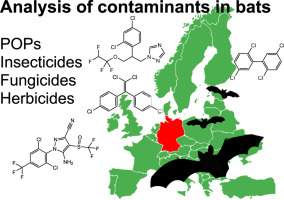Abstract: Bats are strictly protected throughout Europe. They are a highly diverse order of mammals in terms of body size, body weight, migratory behaviour, trophic niche specialisation and habitat use. The latter ranges from urban areas and arable land to forest. Due to their low reproductive rate, environmental stressors can have a major impact on bat populations. Pesticides in particular are discussed as an important driver of bat population declines. In this work, we analysed nearly 400 animals of five different species (Eptesicus serotinus, Myotis myotis, Nyctalus noctula, Pipistrellus pipistrellus, and Plecotus auritus) from all over Germany for residues of 209 pesticides and persistent organic pollutants. Residue analysis was conducted with a previously developed method using a miniaturized quick, easy, cheap, effective, rugged and safe (QuEChERS) sample preparation and gas chromatography-tandem mass spectrometry for separation and detection. These analytical data were statistically correlated with the known data on the animals (e.g. age, sex, place and time of finding). Of 209 pesticides and pollutants investigated, 28 compounds were detected, the most frequent being organochlorine insecticides and polychlorinated biphenyls, which have been banned for decades by the Stockholm Convention on Persistent Organic Pollutants. Detection of more recent pesticides that were legally used for the last decade included azole antifungals and the insecticide fipronil. The bats contained between four and 25 different residues. Statistical data analyses showed that the distribution throughout Germany is largely comparable, and single exceptions were observed in specialized ecological niches. In conclusion, this work provides the largest dataset of pesticide and persistent organic pollutant residues in European bats to date.

Original Studie:
Schanzer, S., Koch, M., Kiefer, A., Jentke, T., Veith, M., Bracher, F., Bracher, J., Müller, C. (2022). Analysis of pesticide and persistent organic pollutant residues in German bats. Chemosphere, 135342.
